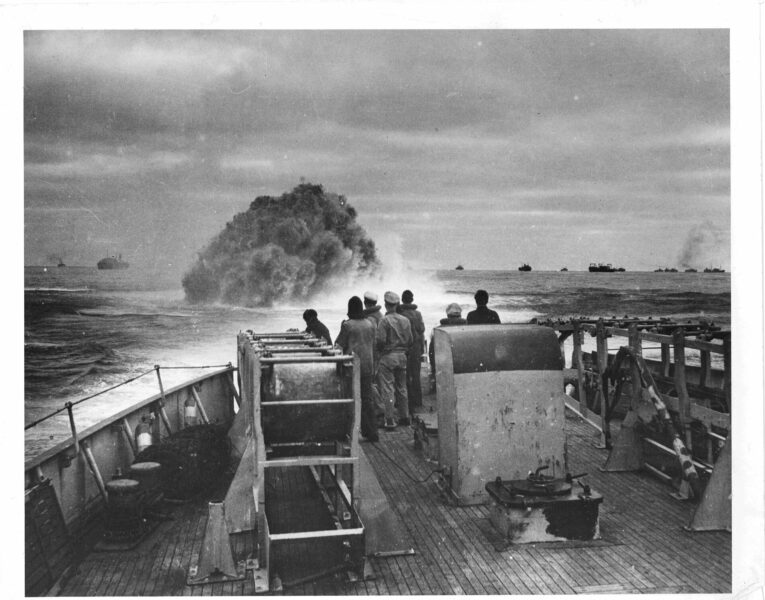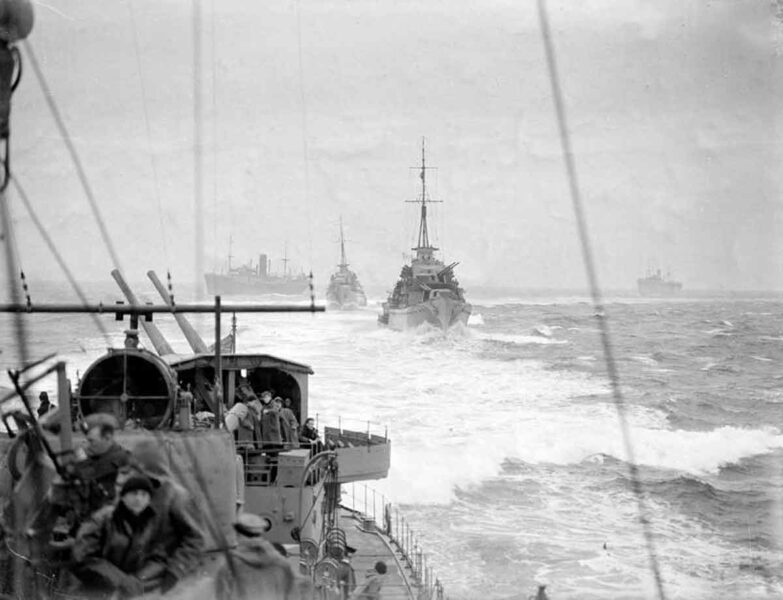TOGETHER, LET’S DISCOVER THE TRUTH!Help us finance the book and film about the true story of the SL 125.
After years of research, many grey areas remain to be clarified. We need your help to finance the investigation, which will result in a ground-breaking book and documentary. Your support will enable us to find out what really happened to this World War II civilian convoy.
Was the SL125 sacrificed by the Allies to win the war?
Have hundreds of men been sent to certain death?
We’re launching a crowdfunding campaign so that anyone who feels concerned can help us carry out this investigation.
In return for your help, we’ll involve you fully in our research and reward you in a variety of ways, including by associating you with events linked to the book, film and exhibition we’ll be producing!
Thank you for your help. Below is the video presenting our project. Don’t forget to activate the English subtitles at the bottom right of the image !
THE FACTS, OUR INVESTIGATION, THE CLUES
THE FACTS
In mid-October 1942, the Nazi command assembled a fleet of ten U-boats east of the Azores. From 23 October, the submersibles formed the “Streitaxt” (German for axe) group, which stretched from Freetown to the Canaries. On October 25, U-203 reports convoy SL 125, west of the Canaries and some 1,500 km west of Tangiers. A pack of German U-boats attacked the convoy, which consisted of forty-two ships, including a few troop transport units. As its name suggests, the SL 125 is actually heading from Sierra Leone (SL) to Britain. It is barely protected. Her escort consists of a sloop, four corvettes and an armed anti-submarine trawler. The escort really seems inadequate for this type of convoy, especially as the sloop and trawler are called away on another mission…
On October 27, U509 torpedoes the British freighters Pacific Star and Stentor. The U604 sent the British tanker Anglo Mærsk to the bottom while at the end of a convoy, west of the Canary Islands. The attack lasted five days and ended on November 1, 1942, west of Lisbon, with one vessel damaged and eleven others sunk. With 407 casualties, including 260 sailors aboard the French liner “Président Doumer”, the attack was the deadliest on an SL convoy in the whole of the Second World War. The mission of the Streitaxt pack was a success and the Nazi submariners were congratulated on their return to the Lorient base. Curiously, on his arrival in Liverpool, SL 125’s commander, Rear Admiral Sir Cécil Nugent Reyne, was also praised by the British General Staff! He would later say that “it was the first and only time that‘he was complimented for having lost so many ships…”.
The story doesn’t end there. Less than a week later, on November 8, 1942, 200 warships and 140 transport ships landed 107,000 men on the coasts of Algeria and Morocco. It was Operation Torch, the biggest landing of all time, ahead of Normandy. It was to shorten the Second World War and change the face of the world. Also known as the “Three-Day War”, Operation Torch was a success, not least because the surprise effect was so effective.
What exactly happened? The imposing armada set sail from the American and British coasts in mid-October, just as convoy SL 125 left Freetown to head north. It was 50 km long and 40 km wide, but was only discovered by the Germans and their French allies at the very last moment, as the ships approached the Moroccan and Algerian coasts. How were hundreds of ships able to slip through the net set by German submarines?
Between November 2 and 5, Torch’s 340 ships were in fact cruising exactly in the area where the 37 ships of convoy SL 125 had just been attacked by German submarines between October 27 and November 1… fortunately, the submersibles were then returning to their base in Lorient. Coincidence? Certainly not!

THE SURVEY
In most accounts of the period, it is stated that the Allied ships escaped the U-Boats as they were in pursuit of the SL 125 convoy, but all authors refer to a mere coincidence. After the war, only a few historians maintained that the SL 125’s passage through the area could not have been fortuitous. According to them, the convoy might have been sacrificed by the Allies to allow the landing of Operation Torch troops. Could it have been? For 80 years, the word “perhaps” has been used, but no one has ever actually verified this hypothesis…
We invite you to a fantastic investigation into this World War II mystery! Help us to unravel this secret which seems to be only a detail of the greatest conflict in history but which had the greatest consequences. Operation Torch weakened Axis forces on the Soviet front and precipitated the loss of North Africa for the Germans. It also had a major impact in France, since Hitler immediately ordered his troops to cross the demarcation line and invade the Zone Libre. Torch was in fact the first major Allied maneuver of the Second World War. Its success or failure could determine the outcome of the conflict. In London and Washington, no detail was overlooked to ensure its success. And convoy SL 125 was nothing less than a detail… of the utmost importance!
Unlike other civilian convoys of the time, it had not been planned for a long time, and seems to have been built specifically as a decoy for German submarines. Churchill himself admitted as much (see below).
Was it a coincidence or a lie? That is the question. Yes, was it by chance that enemy submarines rammed convoy SL 125, sending eleven of its ships to the bottom and killing over 400 people of all nationalities in the process? Or did the Allies deliberately lead the Third Reich sailors to the convoy, so that they would neglect their rear and let the Operation Torch ships through? At this point in the war, the Allies knew that the Germans could easily decode certain types of message, even though they themselves had succeeded a few months earlier in breaking the codes of the Enigma machine used by the Nazi general staff.
It’s easy for them to let the Germans know that a convoy is about to sail from Freetown to Liverpool.
It’s one of the rules of warfare: to win, you sometimes have to give up and sacrifice a little of your own strength. The Allies did this at other times during the Second World War. They did it for a good cause, to stop that madman Hitler, and this crucial objective for the nations of the free world was well worth a few sacrifices.
But what of the 400 dead in this game of massacre? Were these poor buggers just some of the many victims of the conflict or were they heroes in spite of themselves who were sent to an almost certain death to win the war? We will conduct this investigation, make this film and publish this book to shed light on this dark side of the Second World War and to do justice to these forgotten sailors We will not judge anyone, but we will simply try to find out the truth!

THE INDICES
At the end of October 1942, the aim was not so much to spare the fleet coming from England and the United States as to delay the moment when it would be spotted by enemy submarines. By diverting the U-Boats, convoy SL 125 enabled the ships of Operation Torch to get as close as possible to the beaches of Morocco and Algeria, before pouring in their troops.
The Nazi forces, but also the French government and General De Gaulle, did not learn of the landing until the very last moment. The French forces in Algeria and Morocco, as well as the German air force based in Sicily, were unable to react and engage in the fierce fighting that the Allied command had so feared. If the German submarines had been able to detect the enormous armada of Operation Torch as early as the 3rd, 4th or even 5th of November, there is no doubt that the reaction of the French forces in North Africa, assisted by Luftwaffe aircraft, would have been more significant. Perhaps it would even have compromised the landing… This is the thesis that we will try to demonstrate by carrying out this investigation 80 years after the facts! Churchill’s memoirs, a number of writings and eyewitness accounts from the period, transcripts of radio exchanges, analysis of Operation Torch maps, and disturbing unexplained coincidences are all clues we’ve mentioned in the attached articles, but we need to do more. Clues alone won’t establish the truth: we need to go out and find proof. Who knows if we won’t be able to record unpublished testimonies from survivors, if any, their descendants or indirect witnesses? But above all, we’ll have to redo the investigation and delve into archives that have remained secret, or those that have not yet been examined. We’ll do this with your help and, why not, your advice. Professionals or amateurs, enthusiasts or the simply curious, if you love puzzles, if you are enamored of great History, a fan of the Second World War and naval battles, or more simply, if you are concerned with the truth, you will want to know the one hidden behind this code name “SL 125”!!!!
By participating in our crowdfunding campaign, by becoming a member of our association, you’ll be fully involved in the investigation we’ll be carrying out around the world, and in the making of our film, from London to Washington, from Freetown to Gibraltar, Paris, Glasgow or Oslo. In return for your help, we’ll reward you in a variety of ways, and invite you to events linked to the investigation, the book and the film we’ll be making!

